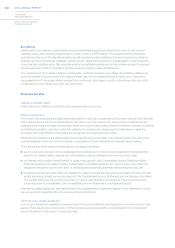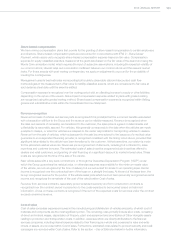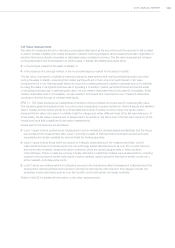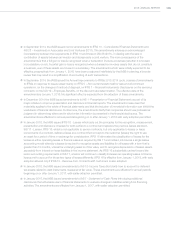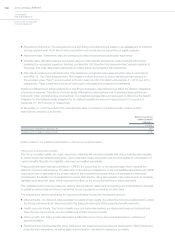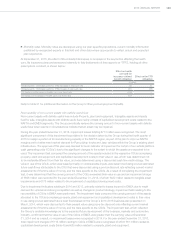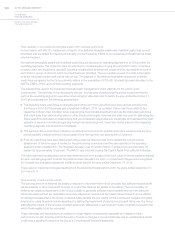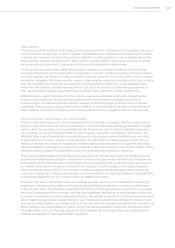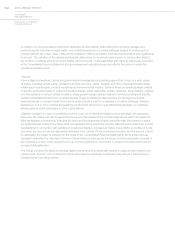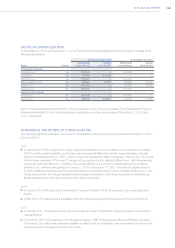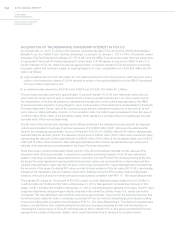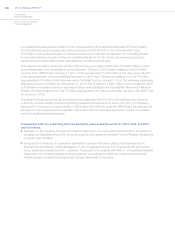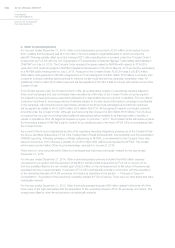Chrysler 2015 Annual Report Download - page 160
Download and view the complete annual report
Please find page 160 of the 2015 Chrysler annual report below. You can navigate through the pages in the report by either clicking on the pages listed below, or by using the keyword search tool below to find specific information within the annual report.
160 2015 | ANNUAL REPORT
Consolidated
Financial Statements
Notes to the Consolidated
Financial Statements
Recoverability of Goodwill and Intangible assets with indefinite useful lives
In accordance with IAS 36 - Impairment of Assets, Goodwill and intangible assets with indefinite useful lives are not
amortized and are tested for impairment annually or more frequently if facts or circumstances indicate that the asset
may be impaired.
Goodwill and intangible assets with indefinite useful lives are allocated to operating segments or to CGUs within the
operating segments. The impairment test is performed by comparing the carrying amount (which mainly comprises
property, plant and equipment, goodwill, brands and capitalized development costs) and the recoverable amount of
each CGU or group of CGUs to which Goodwill has been allocated. The recoverable amount of a CGU is the higher
of its fair value less costs to sell and its value in use. The balance of Goodwill and intangible assets with indefinite
useful lives recognized by the Group primarily relates to the acquisition of FCA US. Goodwill has been allocated to the
NAFTA, EMEA, APAC and LATAM operating segments.
The assumptions used in the impairment test represent management’s best estimate for the period under
consideration. The estimate of the recoverable amount, for purposes of performing the annual impairment test for
each of the operating segments, was determined using fair value less cost to sell for the year ended December 31,
2015 and was based on the following assumptions:
The expected future cash flows covering the period from 2016 through 2020 have been derived primarily from
the Group’s 2014-2018 business plan presented on May 6, 2014, as updated. These cash flows relate to the
respective CGUs in their condition when preparing the financial statements and exclude the estimated cash flows
that might arise from restructuring plans or other structural changes. Volumes and sales mix used for estimating the
future cash flow are based on assumptions that are considered reasonable and sustainable and represent the best
estimate of expected conditions regarding market trends and segment, brand and model share for the respective
operating segment over the period considered.
The expected future cash flows include a normalized terminal period to estimate the future result beyond the time
period explicitly considered which incorporates a long-term growth rate assumption of 2 percent.
Post-tax cash flows have been discounted using a post-tax discount rate which reflects the current market
assessment of the time value of money for the period being considered and the risks specific to the operating
segment under consideration. The Weighted Average Cost of Capital (“WACC”) ranged from approximately 16
percent to approximately 19 percent. The WACC was calculated using the Capital Asset Pricing Model technique.
The value estimated as described above was determined to be in excess of the book value of the net capital employed
for each operating segment to which Goodwill has been allocated. As such, no impairment charges were recognized
for Goodwill and Intangible assets with indefinite useful lives for the year ended December31, 2015.
There were no impairment charges resulting from the impairment tests performed for the years ended December 31,
2014 and 2013.
Recoverability of deferred tax assets
The carrying amount of deferred tax assets is reduced to the extent that it is not probable that sufficient taxable profit
will be available to allow the benefit of a part of or all of the deferred tax assets to be utilized. The recoverability of
deferred tax assets is dependent on the Group’s ability to generate sufficient future taxable income in the period in
which it is assumed that the deductible temporary differences reverse and tax losses carried forward can be utilized.
In making this assessment, the Group considers future taxable income arising on the most recent budgets and plans,
prepared by using the same criteria described for testing the impairment of assets and goodwill. Moreover, the Group
estimates the impact of the reversal of taxable temporary differences on earnings and it also considers the period over
which these assets could be recovered.
These estimates and assumptions are subject to a high degree of uncertainty especially as it relates to future
performance in Latin America and the Eurozone. Therefore changes in current estimates due to unanticipated events
could have a significant impact on the Group’s Consolidated Financial Statements.


